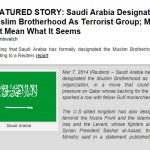THE UNTOLD STORY OF THE FAILED PLOT TO ATTACK PRINCE SULTAN AIR BASE
THE UNTOLD STORY OF THE FAILED PLOT TO ATTACK PRINCE SULTAN AIR BASE
By Ronald Sandee
On June 18, 2002, Saudi Arabia’s Interior Ministry announced the arrest of seven al-Qa’ida members, including six Saudis and a Sudanese national, on suspicion of planning terrorist attacks against vital installations in the Kingdom. The arrests were made several months earlier, according to a spokesman. “The security agencies have arrested elements linked to al-Qa’ida who were planning to carry out terrorist attacks against vital installations in the Kingdom using explosives and two SAM-7 missiles,” the official said.
On the same day, in a statement posted to its website, the London-based, al-Qa’ida-linked Movement for Islamic Reform in Arabia (MIRA) of Sa’ad al-Faqih advised, “the movement affirms what it has stated to the news media and reported in earlier bulletins that the Saudi authorities have indeed discovered weapons in several places with markings indicating that they belong to al-Qa’ida. The markings are in the form of a message that says, ‘we are here.’” The statement continued: “[t]he movement affirms that it announced several months ago the Saudi authorities’ discovery of an operation by al-Qa’ida to smuggle eight US anti-aircraft missiles and three launching pads. The operation was discovered on the Yemeni border. These missiles did not include any Sam missile. The Saudi authorities managed to arrest 6-15 people for investigation.”
The release of the information came after the main suspect, a Sudanese man using the alias Abu Huzaifa, was extradited by the Sudanese to the Saudis on the same day that Sudanese President Bashir arrived in Jeddah for a two-day official visit to Saudi Arabia. A few days earlier, Saudi Foreign Minister Sa’ud al-Faysal probably briefed President Bush, Vice-President Cheney, National Security Advisor Rice and Secretary of State Powell on the Saudi findings of the plot.
According to MIRA, “Saudi authorities had previously concealed the report on these firearms and only announced the discovery of one weapon near Al-Kharj Base, since concealing such reports is not possible.” According to the Saudi Ministry of Interior, the Sudanese national Abu Hufaiza, apparently one of the ringleaders, claimed he had fired a SA-7 surface-to-air missile aimed at American military aircraft at the Prince Sultan Air Base (PSAB), but failed to shoot down an aircraft.
It was reported in Saudi Arabia that this cell’s apparent goal was to shoot down one of the American fighters or other planes based at Prince Sultan Air Base at Al Kharj, south of Riyadh. In 2002, the heavily guarded, isolated base contained the largest share of the 4,500 American military officers and staff members stationed in the Kingdom.
A spokesman for USCENTCOM, said in May 2002, “when the weapon was first discovered that the front of a launching tube for the surface-to-air missile was found intact but that the back had scorch marks, indicating it had been used to fire a missile.” The Pentagon added that the weapon was found two miles from a base runway and within the larger of two perimeter fences. “The remnants of the missile were found at the launching site after their case was known and after investigations were conducted with them,” the official said, adding that the Sudanese national and a second suspect had tried to conceal another missile of the same type in the desert outside Riyadh.
That was about all that came to light about the 2002 attack on the Prince Sultan Air Base until Wikileaks published a massive cache of leaked JTF-GTMO files.
Information contained in the Gitmo files indicates the attack in 2002 was a kind of ‘plan B’ operation. The original plan seems to have been a high priority for the top leadership of al-Qa’ida, and might have entailed at a highly-visible attack with Stinger MANPADs on American fighter jets and other US Air Force planes stationed at Prince Sultan Air Base.
From the Gitmo files we learn that al-Qa’ida’s top military leaders, Mohammed Atef (Abu Hafs al-Masri) and Muhammad Salah al-Din Abd al-Halim Zaydan (Saif al-Adl), as well as the leader of the Chechen jihadis, Ibn Khattab, trained a small Saudi cell consisting of two brothers for an attack on Prince Sultan Air Base.
The two Saudi brothers, Abd al-Razaq Abdallah Hamid Ibrahim al-Sharikh and Abdulhadi Abdallah Ibrahim al-Sharikh, traveled to Afghanistan around September-October 2000. There, they attended al-Qa’ida’s six week basic training course at al-Faruq Training Camp. The basic course provided religious indoctrination and basic instruction in weapons, marksmanship, small unit tactics, and topography. It was commonly used by al-Qa’ida trainers and senior commanders to vet new recruits and screen them for more advanced training and participation in special missions.
Following the basic training, the brothers al-Sharikh were handpicked for a special mission to attack US forces at Prince Sultan Air Base in early 2001 by al-Qa’ida military commander Abu Hafs al-Masri and his second-in-command, al-Qa’ida security chief Saif al-Adl. From this point on, Saif al-Adl and Ibn al-Sheikh al-Libi personally oversaw the two brothers’ training at different al-Qa’ida camps in Afghanistan in order to prepare them for this high-priority mission.
Ibn al-Sheikh al-Libi said that while he was providing explosives training at al-Faruq training camp in April 2001, he was directed by Abu Hafs al-Masri to provide specialized SA-7 training to two Saudi nationals named Akrima and Hammam, which were aliases used by the two Saudi brothers. He provided the training at a special site for three days. After the training, the pair was to conduct attacks against a US military base in Saudi Arabia.
Abd al-Razaq Abdallah Hamid Ibrahim al-Sharikh admitted traveling to Tarnak Farm on the last night of Ramadan 2000 (26 December 2000), and spending seven weeks in specialized training. He claimed that his first instructor was Chechen Mujahidin leader Ibn Khattab, and that he was trained in surveillance, counter surveillance, and intelligence by senior al-Qaida operative Saif al-Adl.
It is worth noting that in April 2001 the FBI reported Khattab and bin Laden were planning an attack against US interests together. As it is known that Khattab was involved with providing al-Qa’ida operatives instructions on how to use MANPADs, Khattab might have actually instructed the two Saudi brothers on the use of SAMs and Stingers.
Abdulhadi Abdallah Ibrahim al-Sharikh said he was trained directly under Saif al-Adl at the Tarnak Farm Training Camp. His training at Tarnak Farm lasted for about two months, with an additional three days of SA-7 training.
Abd al-Razaq Abdallah Hamid Ibrahim al-Sharikh traveled with his brother to Khowst to undergo tactics training after he received the SA-7 training. There, he underwent advanced combat training in the areas of intelligence and surveillance operational tradecraft, explosives, and other weapons, including lessons on how to fire weapons from moving vehicles.
According to Abu Zubaydah, the two brothers paid for specialized training on conducting attacks from vehicles that was provided by former Khaldan Camp instructor Abu Nasser al-Tunisi.
Furthermore, Abdulhadi Abdallah Ibrahim al-Sharikh “possibly trained at the Kandahar Airport complex chemical laboratory. As a result of his selection for a special mission by top al-Qaida leaders, detainee had unique placement within a highly compartmentalized al-Qaida operations cell,” says a JTF-GTMO memo. The memo adds that he “probably had access to the planners and facilitators of the operation against PSAB, some of whom may still be at large in Saudi Arabia or Yemen. Detainee trained at al-Faruq, Tarnak Farm, an LIFG training camp, and possibly the Kandahar Airport complex chemistry lab.”
Believed to have been part of the plot to attack PSAB as he was also trained to fire MANPADs, Humud Dakhil Humud Sa’id al-Jadani visited the al-Qa’ida guesthouse in Kandahar at some point in 2001. Traveling at the time with his close associate Abdulhadi Abdallah Ibrahim al-Sharikh, al-Jandani attended a meeting with the commander of al-Qa’ida’s maritime operations, Mullah Bilal aka (Abd al-Rahim Hussein Muhammad al-Nashiri). It is likely al-Nashiri, who primarily operated in the Gulf area, visited Kandahar to arrange the transfer of the MANPADs to the Arabian Peninsula as al-Nashiri would have been responsible for transporting the MANPADs that had been shipped from Pakistan to Yemen.
Following their training, the two Saudi brothers were deployed to the front in Bagram, north of the Afghan capital Kabul. With al-Qa’ida’s Brigade 55, they fought the Northern Alliance and the first Western troops to arrive in Afghanistan following the 9/11 attacks.
After the collapse of northern front, the Saudi brothers headed for the fallback position in Tora Bora. When Tora Bora fell, they crossed the border into Pakistan with a group of al-Qa’ida fighters led by Ibn al-Sheikh al-Libi. The day after the group arrived in Parachinar they were arrested by local authorities. Pakistani authorities apprehended a group of 32 other Arabs, which consisted mostly of UBL bodyguards, at some point around 15 December 2001. The group was transferred to a prison facility in Peshawar. On 26 December 2001, they were transferred to US forces and transported to Kandahar. These 32 detainees were referred to as “The Dirty 30.”
The arrests of the two Saudi brothers and others involved with the PSAB plot disrupted a well-planned attack on a major military installation in the Middle East.
Following the death of Abu Hafs al-Masri, it was probably Saif al-Adl who decided to move ahead with the plan to attack PSAB using a new group of fighters. Further, it is likely al-Adl assessed the risk of detection was too high to warrant the fielding of al-Qa’ida’s Stinger MANPADs.
Indeed, it was only logical to use a SA-7 in a close-range attack like this. Interestingly, when Sudanese al-Qa’ida operative Abu Hufaiza fired a SA-7 within close range of PSAB it was not detected.




